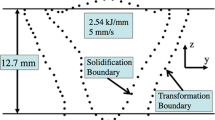Abstract
The concept of constructing parameter spaces for process control and the prediction of properties within the heat affected zone (HAZ) of welds using inverse modeling is examined. These parameter spaces can be, in principle, either independent or a function of weld process conditions. The construction of these parameter spaces consists of two procedures. One procedure entails calculation of a parameterized set of temperature histories using inverse heat transfer analysis of the heat deposition occurring during welding. The other procedure entails correlating these temperature histories with either a specific process control parameter or physical property of the weld that is measurable. Two quantitative case study analyses based on inverse modeling are presented. One analysis examines the calculation of temperature histories as a function of process control parameters. For this case, the specific process control parameter adopted as prototypical is the electron beam focal point. Another analysis compares some general characteristics of inverse and direct modeling with respect to the prediction of properties of the HAZ for deep penetration welding of aluminum alloys. For this case, the specific property adopted as prototypical is hardness. This study provides a foundation for an examination of the feasibility of constructing a parameter space for the prediction of weld properties using weld cross-section measurements that are independent of weld process conditions.











Similar content being viewed by others
References
S.G. Lambrakos and J.O. Milewski, “Analysis of Welding and Heat Deposition Processes using An Inverse-Problem Approach,” Mathematical Modelling of Weld Phenomena, 7, p 1025, Verlag der Technischen Universite Graz, Austria, 2005
Kou S. (2003) Welding Metallurgy. Hoboken, John Willey & Sons Inc, New Jersey, pp. 359–362
Malin V. (1995) Aluminum welded joints, Study of Metallurgical Phenomena in the HAZ of 6061-T6. Welding Journal 74(9):305–318
Engstrom A., Hoglud I., Agren J. (1994) Computer Simulation of Diffusion in Multiphase Systems. Metallurgical Materials Transactions 25A:1127–1134
Vermolen F.J., Vuik C. (2000) A mathematical model for the dissolution of particles in multi-component alloys. Journal of Computational and Applied Mathematics 26:233–254
Bratland D.H., Grong O., Schercliff H., Myhr O.R., Tjotta S. (1997) Modelling of precipitation reactions in industrial processing. Acta Materialia 45:1–22
Nicolas M., Deschamps A. (2003) Characterisation and modelling of precipitate evolution in an Al-Zn-Mg alloy during non-isothermal heat treatments. Acta Materialia 51:6077–6094
Grong O., Myhr H. (2000) Modelling of non isothermal transformations in alloys containing a particle distribution. Acta Materialia 45:1–22
Grong O. (1997) Metallurgical Modelling of Welding. The Institute of Materials, Cambridge University Press, UK, pp 325–334
Ion J.C., Easterling K.E., Ashby M.F. (1984) A second report on diagrams of microstructure and hardness for HAZ in welds. Acta Materialia 32:1949–1962
Bjorneklett B.I., Grong O., Myhr H., Kluken A.O. (1998) Additivity and isokinetic behavior in relation to particle dissolution. Acta Materialia 46:6257–6266
Nicolas M., Deschamps A. (2002) Precipitate microstructure in the Heat-Affected Zone of Al-Mn-Mg MIG-Welds and evolution during Post Welding Heat Treatments. Materials Science Forum 396–402:1561–1566
Agren J. (1990) Kinetics of Carbide dissolution. Scandinavian Journal of Metallurgy 9:2–8
A. Gustafson: “Aspects of Microstructural Evolution in Chromium Steels in High Temperature Applications,” Ph.D. Dissertation, KTH, Sweden, 2000
A. Gustafson, L. Hoglud, and J. Agren: “Simulation of Carbo-Nitride Coarsening in Multicomponent Cr-Steels for High Temperature Applications,” Advanced Heat Resistant Steels for Power Generation. IOM Communications Ltd., London, p 270–276, 1998
Gustafson A. (2000) Coarsening of TiC in austenitic stainless steel-experiments and simulations in comparison. Materials Sci. Eng. A287:52–58
A. Prikhodovski, I. Hurdado, P.J. Spencer, and D. Neuschutz: “Mathematical Simulation of Microstructure Coarsening During Preheating of Aluminium Alloys,” Proceedings of the 5th International Conference on Semi-Solid Processing of Alloys and Composites, Colorando, p 249–256, 1998
Lifshitz I.M., Slyozov V.V. (1961) The kinetics of precipitation from supersaturated solid solutions. J. Phys. Chem. Solids 19:35–50
Wagner C. (1961) Theorie der Altrung von Nieederschlagen durch Umblosen (Ostwald-Reinfund). Z. Electrochem 65:581–591
Bishop M., Fletcher K.E. (1972) Diffusion in Aluminium. Intern. Metallurgical Reviews 17:203–225
Sudman B., Jonsson B., Andersson J.-O. (1985) The Thermo-Calc databank system. CALPHAD 9:153
Acknowledgments
The authors would like to thank Mr. Vassilis Stergiou of HAI for performing EB experiments. Some of the calculations presented here (thermal histories) are based on work supported by a Naval Research Laboratory 6.1 Core program in welding. In particular, S.G.L would like to thank the Department of Mechanical Engineering at the University of Thessaly for its continued collaboration concerning welding and materials processing.
Author information
Authors and Affiliations
Corresponding author
Rights and permissions
About this article
Cite this article
Zervaki, A., Haidemenopoulos, G. & Lambrakos, S. Analysis of Heat Affected Zone in Welded Aluminum Alloys Using Inverse and Direct Modeling. J. of Materi Eng and Perform 17, 402–410 (2008). https://doi.org/10.1007/s11665-007-9145-9
Received:
Accepted:
Published:
Issue Date:
DOI: https://doi.org/10.1007/s11665-007-9145-9



